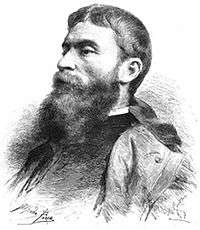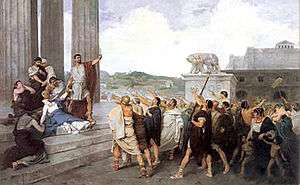Casto Plasencia


Casto Plasencia y Maestro (17 July 1846, Cañizar – 18 May 1890, Madrid) was a Spanish painter of landscapes, portraits and murals.
Biography
His father was a rural doctor, and he was orphaned as a teenager.[1] Under the sponsorship of several local nobles, he travelled to Madrid and entered the Real Academia de Bellas Artes de San Fernando, where he became one of the first students who received fellowships to the new "Academia Española de Bellas Artes de Roma".[2] His initial success came in 1878 with his "Origin of the Roman Republic", which won First Prize at the Exposición Nacional de Bellas Artes and Third Prize at the Exposition Universelle in Paris.[1]
After becoming established in Madrid, he was chosen to do portraits of King Alfonso XII and Queen María. He also stood out as a painter of religious subjects. As the Assistant Manager on a project at the San Francisco el Grande Basilica, he participated in decorating the main cupola[2] and was in charge of the paintings for the chapel of the Order of Carlos III. He was also involved in decorating the Palacio del Marqués de Linares[1] and was one of the founding members of the Círculo de Bellas Artes.
In the summer of 1884, his fellow painter Tomás García Sampedro invited him to visit Muros del Nalón in Asturias. He was charmed by the area and continued to visit there every summer with other painters and students who formed what came to be known as the "Colonia de Muros", a group devoted to plein-air painting in the surrounding countryside.[2]
References
- 1 2 3 Biografías de Gentes de Guadalajara
- 1 2 3 Brief biography @ the Museo del Prado website.
Further reading
- Juan Dijes Antón, Manuel Sagredo y Martín: Biografías de Hijos Ilustres de la Provincia de Guadalajara. Tipografia y encuadernación provincial, Guadalajara, 1889.
- Esteban Casado Alcalde: Pintores de la Academia de Roma. La primera promoción. Barcelona: Lunwerg Editores, 1990, ISBN 84-7782-088-0.
External links
| Wikimedia Commons has media related to Casto Plasencia. |
- ArtNet: More works by Plasencia
- Brief biography @ MCN Biografías